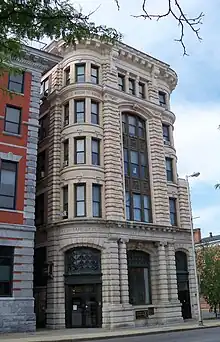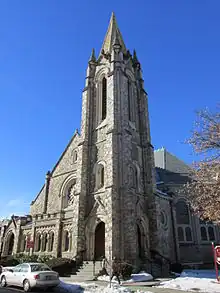Percival Lloyd
Percival Lloyd (1872–1915) was an American architect in practice in Poughkeepsie, New York, from 1895 until 1915. A number of his works are listed on the United States National Register of Historic Places.[1][2]
Percival Lloyd | |
|---|---|
| Born | January 28, 1872 |
| Died | March 6, 1915 (aged 43) |
| Nationality | American |
| Occupation | Architect |


Life and career
Percival Monell Lloyd was born January 28, 1872, in Poughkeepsie to Russell G. Lloyd and Florence (Monell) Lloyd. He was educated in the local public schools and at the Riverview Military Academy.[3] In 1894 he joined the office of leading local architect Arnout Cannon Jr., and became his business partner in the firm of Cannon & Lloyd in 1895.[4] Cannon's declining health led him to commit suicide in 1898, and Lloyd continued the business alone. Lloyd practiced independently until late 1914, when due to his own declining health he took a leave of absence from his office and entered a sanatorium in Saranac Lake, where he died March 6, 1915. He never married.[3]
Lloyd was a member of the New York Society of Architects, established in 1906, and was elected to the board of directors in 1914.[5]
Legacy
According to its National Register nomination, the First Presbyterian Church in Poughkeepsie is "perceived as 'beautiful'", and is regarded as one of Lloyd's greatest works. "It is indeed an imposing and unique structure in Poughkeepsie".[6] His Poughkeepsie Trust Company Building is a Beaux Arts building that was the Hudson Valley's first modern skyscraper at six stories in height, costing $100,000 to build.[7]
The regional architects Edward C. Smith of Poughkeepsie and George E. Lowe of Kingston both worked in Lloyd's office.[8]
Architectural works
- House,[lower-alpha 1] 32 Balding Ave, Poughkeepsie, New York (1896)[9]
- House,[lower-alpha 2] 151 Academy St, Poughkeepsie, New York (1901)[10]
- First Presbyterian Church, 25 S Hamilton St, Poughkeepsie, New York (1905–08, NRHP 1982)[6]
- Poughkeepsie Trust Company Building, 236 Main St, Poughkeepsie, New York (1906, NRHP 1982)[7]
- Poughkeepsie YWCA, Cannon St, Poughkeepsie, New York (1906, demolished)[3]
- House,[lower-alpha 3] 81 Hooker Ave, Poughkeepsie, New York (1907)[11]
- Lady Washington Hose Company building, 20 Academy St, Poughkeepsie, New York (1908, NRHP 1982)[12]
- FIAT assembly plant, North Rd and Fulton St, Poughkeepsie, New York (1909, demolished)[13]
- Niagara Engine House, 8 N Hamilton St, Poughkeepsie, New York (1909, NRHP 1982)[14]
- Luckey, Platt & Company Department Store annex, 332 Main St, Poughkeepsie, New York (1910, NRHP 1982)[15]
- House,[lower-alpha 3] 9 Dwight St, Poughkeepsie, New York (1911)[11]
- Clarence Kenyon house, 260 Boardman Rd, Poughkeepsie, New York (1913)[13]
- Mader House, 101 Corlies Ave, Poughkeepsie, New York (before 1925, attributed, NRHP 1982)[16]
Notes
- A contributing property to the Balding Avenue Historic District, NRHP-listed in 1982.
- A contributing property to the Academy Street Historic District, NRHP-listed in 1982.
- A contributing property to the Dwight–Hooker Avenue Historic District, NRHP-listed in 1982.
References
- "National Register Information System". National Register of Historic Places. National Park Service. July 9, 2010.
- Poughkeepsie MRA
- "Percival Lloyd Dies at Saranac" in Poughkeepsie Daily Eagle, March 6, 1915, 5.
- "Arnout Cannon" in Commemorative Biographical Sketches of the Counties of Dutchess and Putnam, New York (Chicago: J. H. Beers & Company, 1897): 913–914.
- "Annual Meeting New York Society of Architects" in American Architect'' 105, no. 2007 (June 10, 1914): 5.
- Townley McElhiney Sharp (August 1980). "National Register of Historic Places Registration:First Presbyterian Church". New York State Office of Parks, Recreation and Historic Preservation. Retrieved 2011-12-20.
- Sharp, Townley (1980-08-07). "National Register of Historic Places nomination, Poughkeepsie Trust Company". Retrieved 2008-04-14.
- "The History of New York State".
- Balding Avenue Historic District NRHP Registration Form (1982)
- Academy Street Historic District NRHP Registration Form (1982)
- Dwight–Hooker Avenue Historic District NRHP Registration Form (1982)
- Lady Washington Hose Company NRHP Registration Form (1982)
- Joyce C. Ghee and Joan Spence, Poughkeepsie 1898–1998: A Century of Change (Charleston: Arcadia Publishing, 1999)
- Niagara Engine House NRHP Registration Form (1982)
- Luckey, Platt & Company Department Store NRHP Registration Form (1982)
- Mader House NRHP Registration Form (1982)